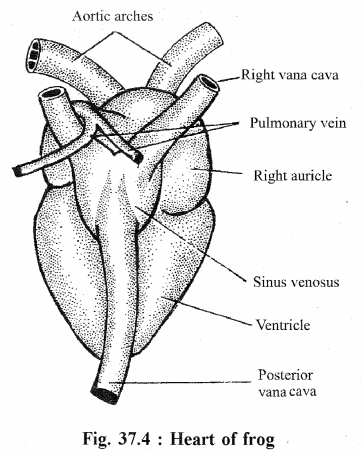Rajasthan Board RBSE Class 11 Biology Chapter 37 Frog
RBSE Class 11 Biology Chapter 37 Multiple Choice Objective Questions
Question 1.
The class of frog is –
1. Mammalia
2. Amphibia
3. Reptelia
4. Pisces
Question 2.
Frog is
1. Carnivorous
2. Herbivorous
3. Omnivorous
4. Frugivorous
Question 3.
The heart of frog is
1. 2-chambered
2. 4-chambered
3. 3-chambered
4. 1-chambered
Question 4.
Respiration in frog is through the
1. Skin
2. Buccopharyngeal cavity
3. Lungs
4. All
Question 5.
Fertilization in frog is
1. Internal
2. External
3. Sometime internal & sometime external
4. Neither internal nor external
Question 6.
The larva of frog is
1. Tadpole
2. Nymph
3. Tomaria
4. Bipinnaria
Question 7.
The frog is
1. Uricotelic
2. Ammonotelic
3. Ureotelic
4. All the above
Question 8.
The number of cranial nerves in frog
1. 12 pairs
2. 10 pairs
3. 8 pairs
4. 14 pairs
Answers :
(1). 2
(2). 1
(3). 4
(4). 4
(5). 2
(6). 1
(7). 3
(8). 2
RBSE Class 11 Biology Chapter 37 Very Short Answer Questions
Question 1.
The Indian frog is commonly called as ?
Answer :
Indian bull frog.
Question 2.
Write the zoological name of frog.
Answer :
Rana tigrina
Question 3.
Write the habitat of Rana tigrina.
Answer :
Amphibious – More in water & less on land.
Question 4.
What is the food of frog ?
Answer :
Insects, small fishes, small frogs etc.
Question 5.
Give the salient feature of tongue of frog.
Answer :
Muscular, bifid & free posterior slimy and used to capture prey.
Question 6.
What type of blood vascular system is found in frog?
Answer :
Closed type
Question 7.
Which type of kidneys are found in frog?
Answer :
Mesonephric
Question 8.
Give the site of embryonic development in frog.
Answer :
Water
Question 9.
Write the name of larva of frog.
Answer :
Tadpole
Question 10.
Through which structure the gametes (Ova & sperms) are released in frog?
Answer :
Cloacal aperture
Question 11.
How the croaking sound of frog is produced?
Answer :
Croaking is produced by vocal sacs in male
Question 12.
In which part of heart of frog the oxygenated & deoxygenated blood get mixed?
Answer :
Ventricle
Question 13.
Which types of eyes are found in frog?
Answer :
Simple eyes
Question 14.
Write the main excretory substance of frog.
Answer :
Urea
RBSE Class 11 Biology Chapter 37 Short Answer Questions
Question 1.
Give an account of the habit and habitat of frog.
Answer :
It is amphibious but leads more aquatic life to keep the skin moist. It inhabits ponds, ditches etc. It is neither poisonous nor harmful. It is poikilothermic. It shows jumping (leaping) locomotion on the ground.
Question 2.
Explain external features of frog.
Answer :
The body of frog is streamlined. It’s anterior end is narrow and the posterior end is broad and somewhat round. The length is about 12 to 18 cm and the width is 5 to 8 cm.
Question 3.
What is hibernation in frog.
Answer :
Frog is a cold blooded animal, hence it’s temperature varies with the environment.During winter, when the environmental temperature becomes low, it stops feeding and burrows in the soil at a depth of 30 to 60 cm. The metabolic activities are reduced to minimum and its respires only by moist skin. It is called as hibernation At the end of winters and beginning of spring season, it again becomes active.
Question 4.
Draw a labelled diagram of alimentary canal of frog.
Answer :
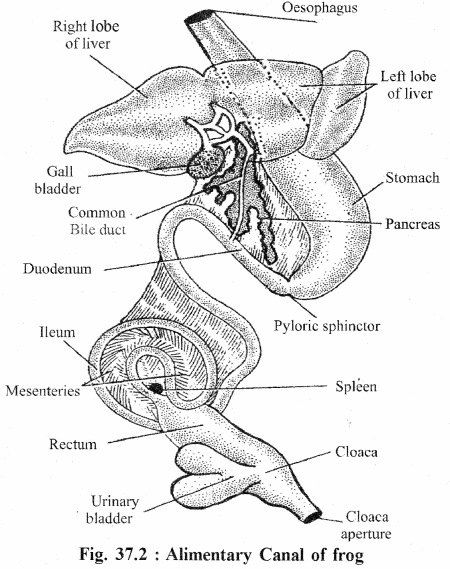
Question 5.
Give the role of digestive enzymes in frog.
Answer :
They are needed to begin the process of digestion. They pump out gastric juices which contain HCI and protein-digesting enzymes.
Question 6.
Which type of respiration is performed by frog inside and outside the water?
Answer :
Being an amphibious animal, the frog exhibits both aquatic and aerial respiration.
Question 7.
Draw a labelled diagram of heart of frog showing external features.
Answer :
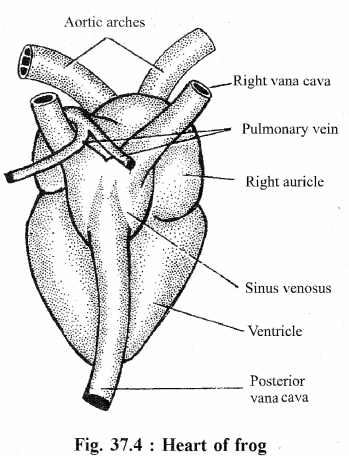
Question 8.
Write the process of blood circulation in frog.
Answer :
It includes blood, heart and blood vessels
(A) Blood :
The blood is red and made up of plasma (60%) & blood corpuscles (40%). The blood corpuscles are of three types viz. –
- Red blood corpuscles : They contain hemoglobin.
- White blood corpuscles
- Thrombocytes.
(B) Heart :
It is a triangular (cone-shaped), dark red in color and muscular structures. It is situated in the anterior part of body cavity at the level of fore limbs. It consists of two anterior auricles (left and right) and one posterior ventricle. Both the auricles open into the ventricle through a common auriculo-ventricular aperture.
There is a triagular sinus venosus which receives two precavals and one post caval. The sinus venous opens into the right auricle. There is truncus arteriosus on the right ventral side of the heart. The ventricle opens into the truncus arteriosus. The left auricle receives pulmonary veins.
(C) Blood Vessels ;
In includes arterial system (various types of arteries) and venous system (various types of veins). The veins form
two types of portal systems viz. –
- Hepatic portal system – In liver
- Renal portal system – In kidneys
Question 9.
Describe the structure of brain of frog.
Answer :
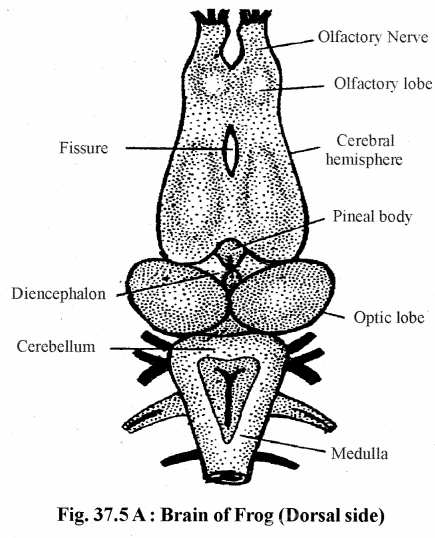
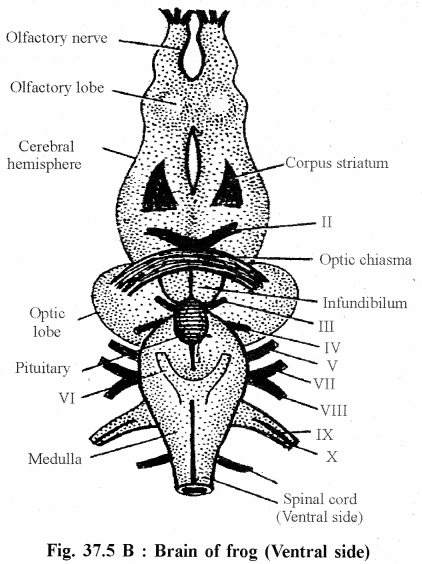
Question 10.
Which types of sense organs are found in frog.
Answer :
Following sense organs are found in the frog –
- Cutaneous receptors : Various types of sense organs are found in the skin below the epidermis which are sensory to various stimuli such as touch, cold, heat, light, pain etc.
- Gustoreceptors : They are few and found on the tongue & in the roof of bucco-pharvngeal cavity. They are sensory’ to taste.
- Olfactoreceptors : They are found in the nostrils and are sensory to smell.
- Eyes : They are sensory to light. One pair of eyes are movable situated in the eye orbits on the head. The eyes are large & round. The wall of eye ball is made up of three layers viz. – sclerotic, choroid and retina.
The 1/3 outer part of sclerotic modifies to form transparent cornea. The image forms on the retina. - Ears : The frog bears a pair of ears. Each ear consists of only’ middle ear and internal ear. The external ear is absent in the frog. The ears are meant for hearing and they also maintain body balance. The tympanum is visible from outside.
Question 11.
Differentiate male and female frog.
Answer :
Frog exhibits sexual dimorphism and the characters
are as follows-
- The male is darker than female.
- Male is comparatively bigger than female.
- The male has a pair of vocal sacs which become prominent during breeding season.
- The first finger of hand of male has a copulatory or amplexury pad which becomes prominent during breeding season. The pads are used to hold female during compilation.
Question 12.
Write the name of endocrine glands and their hormones in frog.
Answer :
Endocrine glands & their Hormones :
| Gland | Hormone |
| 1. Hypothalamus 2. Pituitary gland 3. Thyroid gland 4. Adrenal glands 5. Testes 6. Ovaries 7. Pancreas |
Oxytocin, vasopressin FSH, LH, MSH, Prolactin Thyrotropin Thyroxine (T3 & T4) Corticosterone Androgen Progesterone. Estrogen Insulin, Glucagon |
Question 13.
Draw a labelled diagram of male reproductive system of frog.
Answer :
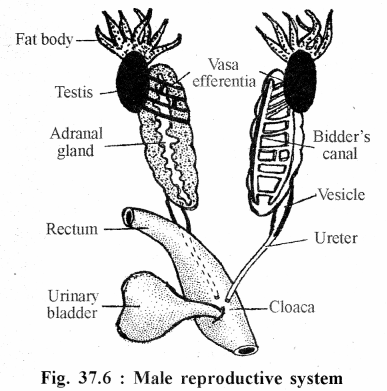
Question 14.
Draw a labelled diagram of female reproductive system of frog.
Answer :
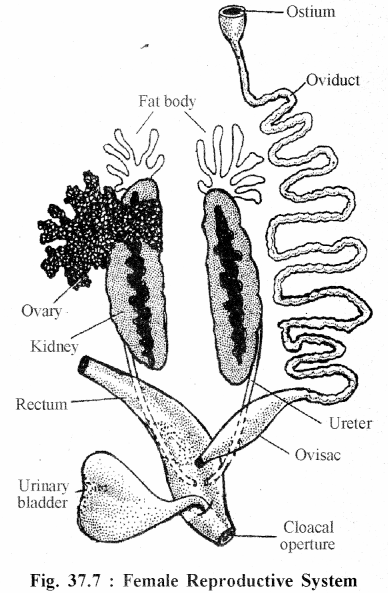
Question 15.
What is the role of HCI in the process of digestion.
Answer :
It makes the food strongly acidic and acts as germicidal.
RBSE Class 11 Biology Chapter 37 Essay Type Questions
Question 1.
Describe the morphology of the frog.
Answer :
Shape and Size :
The body of frog is streamlined. It’s anterior end is narrow and the posterior end is broad and somewhat round. The length is about 12 to 18 cm and the width is 5 to 8 cm.
Skin Colour :
The frog is bounded by a soft, thin, smooth and slimy skin. It is loosely attached to the body. The skin color is green dorsally with lines and spots. Ventrally the skin is pale yellow in color. The skin of male frog is darker than female frog.
Body Division :
The body of the frog is divisible into head and trunk The neck is absent to avoid friction during swimming.
- Head : The head of the frog is triangular and narrow anterior. The snout is broad and blunt, and it bears a broad mouth a pair of external nares. The head bears a pair of large and projected eyes which are situated on both the dorso-lateral sides. Each eye is guarded by a pair of upper and lower eye lids which are movable. In addition, each eye has a third eyelid called nictitating membrance which is thin & transparent. It covers the eye inside the water.
The head also bears a pair of tympanum which are situated as dark and round patches below the eyes. - Trunk : The trunk is broad, somewhat round and attached directly to the head. The trunk is attached with a pair of fore limbs and a pair of hind limbs. The fore limbs are relatively shorter and are tetradactylus (thumb is absent). The hind limbs are longer, Z-like, webbed and pentadactylus. The first finger of fore limb develops copulatory pad in male during the breeding season. It is used to hold the female during copulation. The fingers of both the fore limbs and hind limbs are without claws.
Frog exhibits sexual dimorphism and the characters –
are as follows-
- The male is darker than female.
- Male is comparatively bigger than female.
- The male has a pair of vocal sacs which become prominent during breeding season.
- The first finger of hand of male has a copulatory or amplexury pad which becomes prominent during breeding season. The pads are used to hold female during compilation.
Question 2.
Describe the physiology of digestion in frog.
Answer :
Food and Digestion :
Frog is a carnivorous animal and its food includes insects, worms, small fishes, small frogs etc.
It feeds with the help of slimy tongue and it in gulf the whole prey. The digestion process in the various parts of the alimentary canal is as follows :
| Digestive Juice | Source | Enzymes & their role | Other secretions & their role |
| 1. Gastric Juice | Stomach | (i) Pepsin – It is secreted in inactive form pepsinogen. It converts proteins into peptones and proteoses. | (i) HCI – It acts as strong germicidal and makes the food acidic. |
| 2. Bile Juice | Liver into Duodenum | (i) It is without enzyme. It makes the medium of chyme into alkaline. | (i) It performs emulsification of fat in which large fat globules are converted into tiny droplets which provide more surface for enzyme action. |
| 3. Pancreatic Juice | Pancreas into Duodenum | (i) Trypsin – It converts proteins into peptones & proteoses (ii) Amylopsin or Amylase – It converts starch into desaccharides (Maltose, scucrose) (iii) Lipase or Steapsin – It converts fats into fatty acids & glycerol |
|
| 4. Intestinal Juice | Small Intestine | (i) Maltase – It converts maltose into glucose. (ii) Sucrose – It converts sucrose into glucose and fructose. (iii) Lactase – it converts lactose into glucose and galactose. (iv) Amino peptidases or Erepsin -It convert peptides into amino acids. (v) Lipase – It converts fat into fatty acids and glycerol. |
The Ileum secretes hormones viz.- (i) Enterogasterone – It inhibits secretion of HCI.(ii) Cholecystokinin – It contracts gall bladder to release bile juice. (iii) Secretin & Pancreozyme – they act on pancreas to secrete pancreatic juice. (iv) Enterokinin – It begins the secretion of intestinal juice. |
Question 3.
Describe the nervous system of frog.
Answer :
The nervous system of the frog includes –
- Central nervous system – it includes brain and spinal cord.
- Peripheral nervous system – It includes a pair of ganglionated chains situated on both the sides of the vertebral column.
There are 10 pairs of cranical nerves and 9 pairs of spinal nerves in the frog.
The brain is an elogated white structure which is enclosed in a cranium made up of skull bones. The brain is divisible into three parts viz. – Fore brain. Mid brain and Hind brain.
The fore brain includes a pair of olbactory lobes, a pair of cerebral hemispheres and one diencephalon. Both the cerebral hemispheres are collectively called as cerebrum.
The mid brain consists of a pair of optic lobes. They are hollow and their cavities are called as optocoel.
The hind brain is made up of one cerebellum and one medulla oblongata.
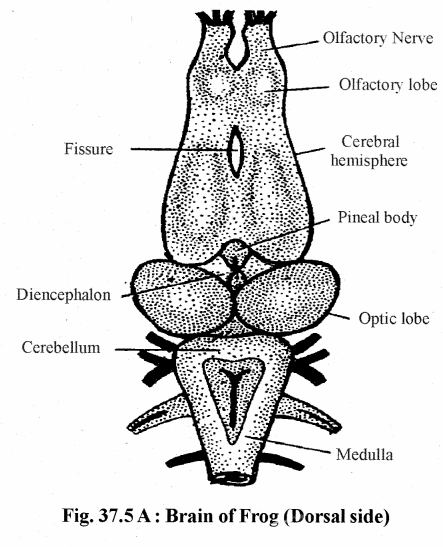
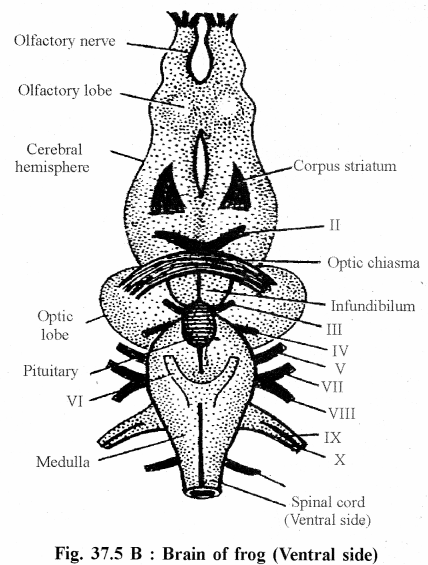
Question 4.
Describe the reproductive system and embryonic development in frog.
Answer :
Reproductive System :
Frog is unisexual i.e. male and female reproductive organs are found in separate animals. Frog exhibits distinct sexual dimorphism.
Male Reproductive System :
The male reproductive system includes following organ-
(i) Testes : There is a pair of testes with are oval, yellow in color and are attached to the anterior-outer side of the kidneys. Each testis consists of many seminiferous tubules which are the structural and functional unit of the testis. The testes form the male gametes called sperms and the process of sperm formation is called as spermatogenesis.
(ii) Vas efferentia & Bidder’s Canal : The testis gives out 10-12 minute Vas efferentia which enter into the respective kidney and open into a Bidder’s canal. The Bidder’s canal is found inside the kidney and it in tum opens into the ureter (urinogenital duct).
In male frog, the urinogenital duct transports both the sperms & urine. Both the urinogenital ducts open separately into the cloaca.
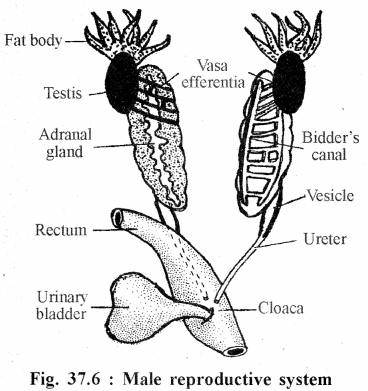
Female Reproductive System :
In female frog, the kidneys are similar to the male kidney but they are not concern with the reproduction. The female reproductive system consists of-
- Ovaries : There is a pair of large, branched and yellow ovaries which are attached to the kidneys superficially only. The form ova by the process of oogenesis. The mature ova are released into the body cavity.
- Oviducts : There is a pair of long, coiled and glandular oviducts or Mullerian ducts. The anterior end of the oviduct is funnel shaped and called as ostium. The middle part is thin and coiled. The posterior part modifies to form an ovisac which temporarily stores the ova. Both the ovisacs open separately into the cloaca.
Physiology of Reproduction :
The frog is a seasonal breeder and it breeds in rainy season. A mature female lays about 2500 to 3000 eggs in a spawn. The eggs are mesolecithal having size about 1 to 2 mm.
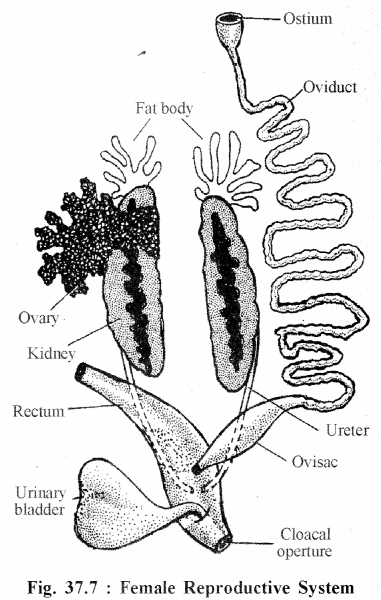
The fertilization is external and development is indirect. The larva is tadpole larva. The tadpole larva metamorphoses to form young frog.
Question 5.
Describe the blood vascular system in frog.
Answer :
It includes blood, heart and blood vessels
(A) Blood :
The blood is red and made up of plasma (60%) & blood corpuscles (40%). The blood corpuscles are of three types viz. –
- Red blood corpuscles : They contain hemoglobin.
- White blood corpuscles
- Thrombocytes.
(B) Heart :
It is a triangular (cone-shaped), dark red in color and muscular structures. It is situated in the anterior part of body cavity at the level of fore limbs. It consists of two anterior auricles (left and right) and one posterior ventricle. Both the auricles open into the ventricle through a common auriculo-ventricular aperture.
There is a triagular sinus venosus which receives two precavals and one post caval. The sinus venous opens into the right auricle. There is truncus arteriosus on the right ventral side of the heart. The ventricle opens into the truncus arteriosus. The left auricle receives pulmonary veins.
(C) Blood Vessels ;
In includes arterial system (various types of arteries) and venous system (various types of veins). The veins form
two types of portal systems viz. –
- Hepatic portal system – In liver
- Renal portal system – In kidneys
